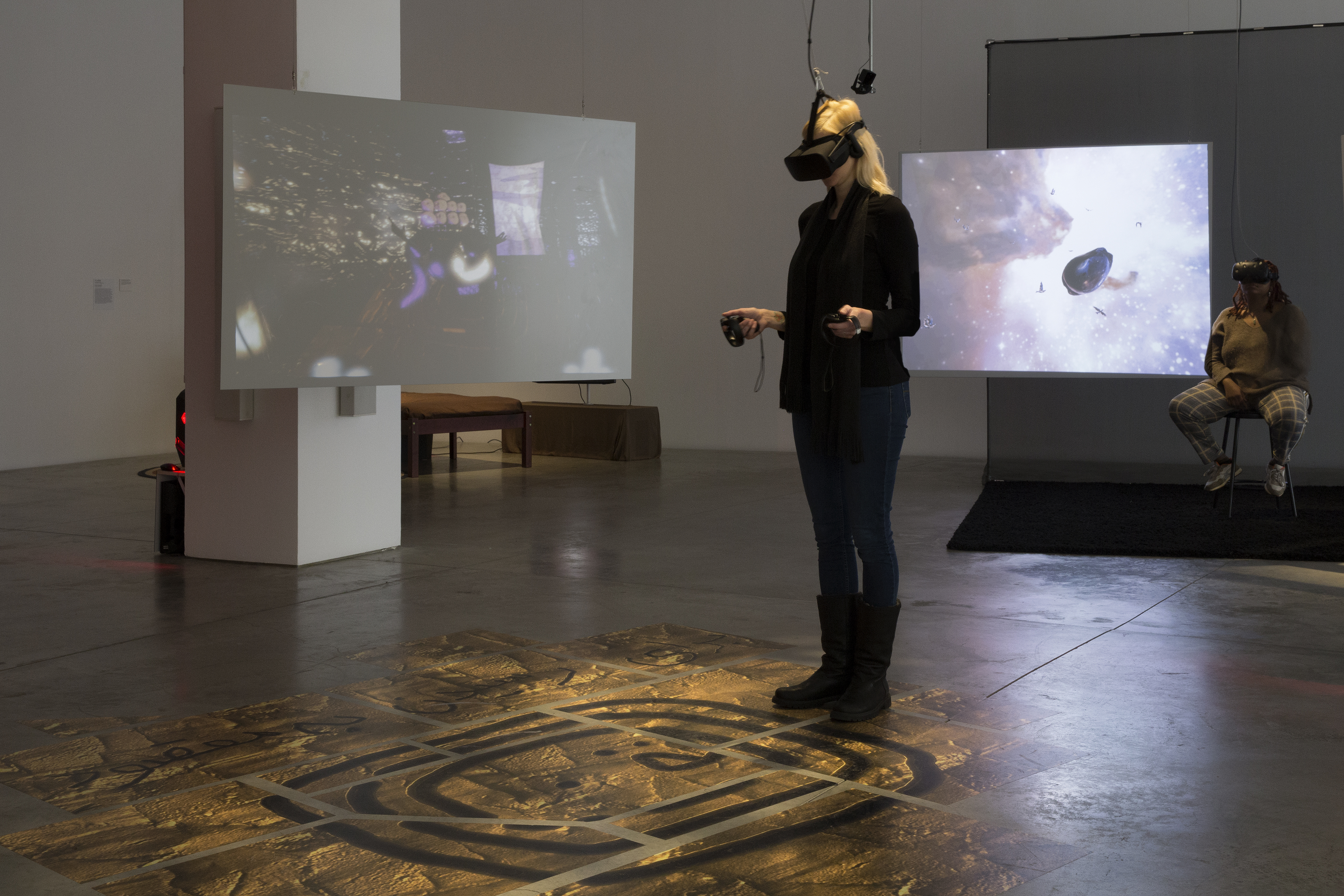peer to space
Generazione Critica: peer to space is an independent international curatorial platform established by Maja Block and Tina Sauerlaender in Munich in 2010, now based in Berlin. At the moment six curators make up the peer to spaceteam: How is your creative process structured and what is your working routine like? How does peer to space benefit from the different backgrounds of its team members?
Tina: Peer to space is an international curatorial collective that collaborates with many different institutions worldwide. We focus on group shows that deal with how the Digital and the Internet shape both society and our personal circumstances. Each of us works as a freelance curator within different fields of expertise: Tina Sauerlaender focuses on Virtual Reality and Self-Representation in the Digital Age, Mara-Johanna Kölmel on (Post-)Digital Sculpture and Decolonizing the Digital, Peggy Schoenegge on performance in XR and Artificial Intelligence, Gloria Aino Grzywatz on Political Perspectives and Diversity & Feminism, and Valentina Peri on Love and Intimacy in the Digital Age as well as Media Histories and Technologies in the Anthropocene. Together, we are a team with diverse skills and fields of knowledge, able to react flexibly and promptly to current trends, i.e. to reflect them in offline and online exhibitions, events, panels or publications. We collaborate on our many projects in different constellations but can always draw on the knowledge of the whole team.
GC: peer to space combines the concept of peer-to-peer networking with the ideas of space, freedom and openness to artistic expression based on a collaborative approach. What is your relationship and dialogue with the artists you work with?
Peggy: Our curatorial approach is characterized by the mediation between artistic works and public perception. The individual artworks deal with important issues of our time, which we contextualize in diverse international group exhibitions, both in the physical and virtual space. Artists critically reflect and use global networks as well as new technologies to question and reposition today’s social, political, cultural or personal circumstances, as well as the perception of global history through digital media. With our exhibitions, we render their works accessible and visible in society and create a broad dialogue and an open space for discussion. We present artistic approaches to a broad audience to create a better understanding of the world we live in—and therefore to contribute to a more tolerant, open-minded and empathic global society. peer to space has existed for more than 10 years and we have worked with approximately 400-500 artists on a wide array of projects. With some artists, we have worked on one specific project, with others, we work more closely, and have presented their works several times over the years.
GC: peer to space’s international group exhibitions are conceived for different locations, both online and physical, and you collaborate with other art spaces to make exhibitions that require an IRL output. How does this process work? How are these collaborations structured?
Tina: We have been working with many different institutions throughout the past decade. With big museums, small project spaces, galleries, or spaces that are not dedicated to art per se. Every collaboration, every institution works differently and we are happy to cope with every new challenge and possibility these spaces present. With the House of Electronic Arts Basel, Switzerland, we have organized a big show on Virtual Reality (The Unframed World, curated by Tina Sauerlaender, 2019). With the Sheila C. Johnson Design Center of Parsons/The New School, New York, we have organized the show Speculative Cultures (2019), curated by Tina Sauerlaender & Peggy Schoenegge from peer to space together with the Mexican, Montréal-based curator Erandy Vergara. We have worked with the Goethe Institut in Montréal for the video screening Deep Water Cultures in 2017. Together with the medienkunstverein, we have realized the show Touching From A Distance II in cooperation with and at Goethe Institut Toronto (2019).
Peggy: Since 2016, peer to space’s team curated 14 online exhibitions in collaboration with many different curators. Here, we aim to challenge ourselves as well as the artists. For example, we decided early on to include traditional haptic media in our online shows (Mermaids & Unicorns, curated by Carlotta Meyer, Benoit Palop and Tina Sauerlaender, 2017), or focuses entirely on Embroidery Art (Claiming Needles, curated by Peggy Schonegge and Darja Zub, 2018). This year, we collaborated with the Cologne-based gallery PRISKA PASQUER on an extensive series of four online exhibitions that all took place in PRISKA PASQUER’s virtual gallery space on the SocialVR and WebVR platform Mozilla Hubs. Four peer to space curators (Tina, Peggy, Gloria and Mara) presented four solo exhibitions of the artists Ornella Fieres, Charlie Stein, Zohar Fraiman and Gabriella Torres-Ferrer for the exhibition series ONE TO ONE.
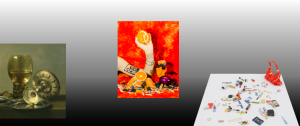
Mermaids and Unicorns, Online exhibition, screenshot, artworks by: Michal Martychowiec, Hobbes Ginsberg, Rose Eken, curated by Carlotta Meyer, Benoit Palop and Tina Sauerlaender, 2017
GC: As you state, peer to space promotes artistic projects that deal with the effects of the Digital and the Internet on our personal environment and society. From your privileged point of view, what are the crucial questions regarding our online life which artists are concerned about these days?
Mara: We believe that the questions that are being negotiated in the online and digital spheres are as diverse as aspects of our IRL lives. Or to say it differently, given the amount of time people spend online, our on- and offline lives are no longer independent of each other. The artists we work with intersect in the observation that the Digital has configured all aspects of cultural life, leading to the end of the novelty of ‘new’ media and its subversive potential. These artistic positions characterise a state in which the logic of the digital realm is inseparably linked to our existence and has brought forth a digital mindset. In what has been termed a post-digital age by artists and theoreticians alike, digital and networked technology are constantly present. In this sense, the digital is not to be understood as a medium, but as a mode of configuration. Crucial concerns of our collaborators also link to questions around participation, representation, and the distribution of power. Who is represented in this hybrid realm of the post-digital and who has the right to participate in it? Whose stories are being silenced or amplified? How are we still connected to each other regardless of our physical locations? How do such connections maintain traditional power relations or give them new forms? These are just a few examples of the broad spectrum of questions that our exhibitions have covered.
GC: PARS PRO TOTO is a series of online screenings of video works that deal with personal and individual experiences linked to cultural, social, political, or environmental issues so that the single narrative becomes part of a collective vision. Can you tell us a bit more about the project?
Gloria: We started the online screening series PARS PRO TOTO in Spring 2020 when the pandemic hit all our lives. We aimed to create an intimate viewing format for the audience to be immersed in at home. The series showcases international video art works which focus on very personal stories narrated by the artist or by another protagonist. The idea behind it is to draw attention to global, cultural, social and political issues from a very personal perspective, in order to create awareness and empathy among the viewers. Each screening is curated by Gloria Aino Grzywatz, who coordinates the whole series, together with another peer to space curator or guest curators. Each iteration is dedicated to a specific theme, on which we show three video works by three different artists. A new volume focusing on a unique topic is released quarterly.
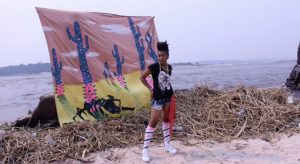
Mukenge/Schellhammer, Your exoticism is my daily bread, video/urban intervention, still, 8:33 min., 2020, on view at the PARS PRO TOTO screening Dreams Of Solidarity at http://www.peertospace.eu/parsprototo
The current screening “Dreams of Solidarity” (online until December 31, 2021) is a cooperation with Akademie Schloss Solitude. The featured artists Caitlin Berrigan, Mukenge/Schellhammer and Hanae Utamura, as well as the three curators, Gloria Aino Grzywatz, Mara-Johanna Kölmel (both peer to space) and Caroline Meyer-Jürshof are current residents of the Akademie. The works speak of unified relationships with non-human worlds, probe decolonial tactics of solidarity within marginalized communities, and emphasize forms of kinships that make up our ecologies and communities.
GC: One of your latest shows is AUGMENTED SPECIES. Invasive Sculptures in Hybrid Ecologies. It is described as “an unauthorized international Touring Exhibition of AR sculptures in Museums and Sculptural Gardens worldwide”, and the artists have been invited to create AR works that take over the hosting institutions’ exhibitions space. How do you conceive the exhibition space and its boundaries? How do you consider the relationship between the digital structure of the artwork and its physical support in the space (the smartphone here, or the VR headset)?
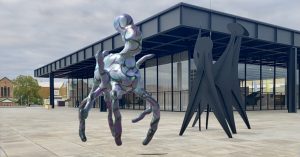
Augmented Species. Invasive Sculptures in Hybrid Ecologies, unauthorized Augmented Reality Exhibition, install shot, work by Sofia Crespo & Feileacan McCormick, curated by Tina Sauerlaender and Ursula Stroebele, organized by MoMAR, Neue Nationalgalerie, Berlin, 2021
Tina: We believe that exhibiting art in the digital age means to use a wide variety of online, offline, and hybrid spaces. We aim to challenge ourselves, the artists we work with, and the art institutions by creating new exhibition forms. This includes art presented with digital devices like apps for the Smartphone or for a Virtual Reality headset. The AR exhibition Augmented Species. Invasive Sculptures in Hybrid Ecologies was curated by Tina Sauerlaender from peer to space and her colleague and friend Ursula Ströbele. It showcases works by the artists Sofia Crespo & Feileacan McCormick, Carla Gannis, Joanna Hoffmann and Tamiko Thiel. These artists work in the field of sculpture, cyber ecology, and eco fiction and deal with new technologies and forms of display. Through their work, they have developed a site-specific sculptural aesthetics of the living, along with expanded possibilities of the sculptural in the digital age. For the show, New York based collective MoMAR organized and developed the exhibition app ‘MoMAR’, which you can download here in the App Store or PlayStore. The concept of MoMAR, an unauthorized non-profit gallery, is to democratize physical exhibition spaces, museums, and the curation of art within them. The exhibition occupies prestigious museum spaces like the MoMA Sculpture Garden in New York, the Centre Pompidou in Paris, or the Neue Nationalgalerie in Berlin (full list of the Augmented Species venues here). While invading physical locations with today’s technological possibilities, we question institutions, their hierarchies, structures and programmes. Who is allowed to exhibit in museums? How can we use digital possibilities to have access to gatekeeping institutions? Who decides about the canon for art in the digital age?
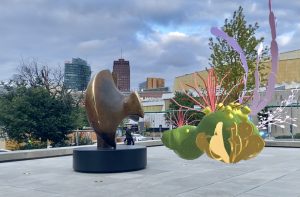
Augmented Species. Invasive Sculptures in Hybrid Ecologies, unauthorized Augmented Reality Exhibition, install shot, work by Tamiko Thiel, curated by Tina Sauerlaender and Ursula Stroebele, organized by MoMAR, Neue Nationalgalerie, Berlin, 2021
GC: What are you currently working on at the moment? Can you give us some insight into next year’s program?
Peggy: On October 28, at 7 pm CET, we will launch our brand new virtual exhibition space on Mozilla Hubs with a big show on virtual sculpture, entitled (IM)MATERIAL MATTER, featuring the artists Banz & Bowinkel, Sofia Crespo & Feileancan McCormick, Mohsen Hazrati, Armin Keplinger, Nadine Kolodziey, Lauren Moffatt, Chiara Passa, Sabrina Ratté and Dagmar Schürrer. The show is curated by Peggy Schoenegge. To get access to the opening, please check our blog here shortly before the event as we will publish the link there.
Additionally, we just opened our recent online show on video sculpture. Paradoxical Objects. Video Sculpture Art From 1968 To Today, featuring the video sculpture works by 47 artists. The show is curated by Peggy Schoenegge and Sue Bachmeier from our team.
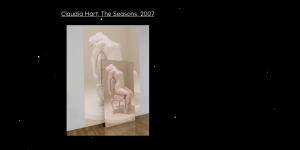
Paradoxical Objects. Video Sculpture Art from 1968 to Today, screenshot, work by Claudia Hart, curated by Sue Bachmeier and Peggy Schoenegge, 2021
Mara-Johanna Kölmel initiated the co-curated audio-visual series REUSE >> REFUSE with the artists Lamin Fofana, Moor Mother, KMRU and Sarvenaz Mostofey in collaboration with transmediale, NTS Radio and the Akademie Schloss Solitude in Stuttgart. She is also working on a number of book projects including the publication of her PhD thesis Sculpture in the Augmented Sphere, as well as edited anthologies Dada Data. Art and Post-Truth Politics (with Sarah Hegenbart) and The Sculptural in the Post-Digital Age (with Ursula Ströbele). Her next show with the Brazilian artist Antonio Tarsis will open mid-December in London.
Gloria has just opened a group show entitled Panoptical Play in collaboration with the SALOON Dresden.
On top of that, Valentina Peri is currently working on Swipe Right! an exhibition about digital intimacies at iMALBrussels, running from October 22 to January 9, 2022. On this occasion, she will launch the book Data Dating. Love, Technology, Desire, Ania Malinowska and Valentina Peri (eds), a collection of ten academic essays accompanied by works of media art that provide a comprehensive insight into the construction of love and its practices in the time of digitally mediated relationships. She is one of the art professionals in residence at PiXii Co–Creation, the first European incubator for immersive projects. In May-June 2022 Valentina will be in residency at the Tirana Art Lab, in the framework of the European project Beyond Matter, an international, collaborative, practice-based research project that reflects on the virtual condition.
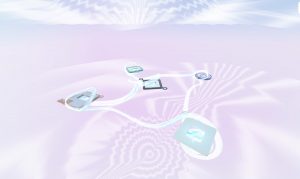
Virtual Art Space by peer to space, 2021
peer to space is an independent exhibition platform that was established in Munich in 2010 and is now based in Berlin. The ever-changing team of curators under the direction of Tina Sauerlaender has realized numerous international group exhibitions in cooperation with institutions and museums such as Parsons / The New School, New York, the Goethe Institutes in Montréal, Toronto, Washington DC and Barcelona, the House of Electronic Arts Basel, or the NRW Forum, Düsseldorf. The name peer to space combines the concept of peer-to-peer networking with the ideas of space, freedom and openness to artistic expression. peer to space is not an actual place but collaborates with other spaces to realize exhibitions and projects related to art dealing with effects of the digital and Internet on our personal environment and society.
©cover image: Speculative Cultures. A Virtual Reality Exhibition, Installation shot, curated by Tina Sauerlaender, Peggy Schoenegge, and Erandy Vergara. Anna-Maria and Stephen Kellen Gallery, Sheila C. Johnson Design Center, Parsons/The New School. Photo: Marc Tatti, 2019
Copyrights – METRONOM
21/11/2021

